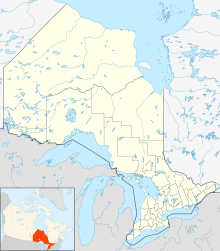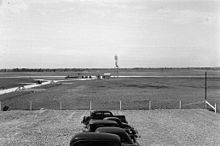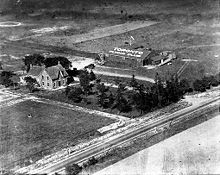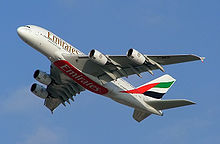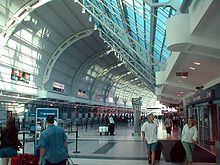- Toronto Pearson International Airport
-
This article is about the Canadian airport. For the airfield in the United States, see Pearson Field. For other airports in Toronto, see List of airports in the Greater Toronto Area."YYZ" redirects here. For the instrumental by Rush, see YYZ (instrumental).
Toronto Pearson International Airport 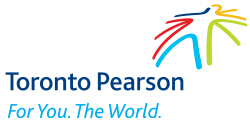
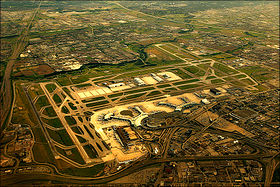
IATA: YYZ – ICAO: CYYZ
– WMO: 71624Summary Airport type Public Owner Transport Canada Operator Greater Toronto Airports Authority (GTAA) Serves Greater Toronto Area Location Mississauga, Ontario Hub for - Air Canada
- Air Canada Express
- Air Transat
- CanJet
- FedEx Express
- Sunwing Airlines
- WestJet
Elevation AMSL 569 ft / 173 m Coordinates 43°40′36″N 079°37′50″W / 43.67667°N 79.63056°WCoordinates: 43°40′36″N 079°37′50″W / 43.67667°N 79.63056°W Website Map Location within Ontario Runways Direction Length Surface ft m 05/23 11,120 3,389 Asphalt/Concrete 15L/33R 11,050 3,368 Asphalt 06L/24R 9,697 2,956 Asphalt 15R/33L 9,088 2,770 Asphalt 06R/24L 9,000 2,743 Asphalt Statistics (2010) Number of Passengers 31,934,395 Aircraft movements 419,044 Sources: Canada Flight Supplement[1]
Environment Canada[2]
Transport Canada[3]
Movements from Statistics Canada[4]
Passengers and Movements from Airports Council International[5]Toronto Pearson International Airport (also known as Lester B. Pearson International Airport or simply Toronto Pearson) (IATA: YYZ, ICAO: CYYZ) is an international airport serving Toronto, Ontario, Canada; its metropolitan area; and the Golden Horseshoe, an urban agglomeration that is home to 8.1 million people – approximately 25% of Canada's population.[6] The airport is located in Mississauga, 22.5 km (14.0 mi) northwest of Downtown Toronto. The airport is named in honour of the late Canadian Prime Minister and Nobel Peace Prize winner Lester Bowles Pearson.
Pearson is the largest and busiest airport in Canada.[7][4][8] In 2010, it handled 31.9 million passengers,[5] and 419,044 aircraft movements.[4] It is currently the world's 20th busiest airport by international passenger traffic and 18th busiest airport by aircraft movements. In 2006, the airport was selected as the best global airport by the UK-based Institute of Transport Management.[9] The airport is the largest hub for Air Canada, making it a major Star Alliance hub airport.[10][11][12][13] It is also a hub for passenger airlines Air Canada Express, Air Transat, CanJet, Sunwing Airlines and WestJet, as well as cargo airline FedEx Express. The airport is operated by the Greater Toronto Airports Authority (GTAA) as part of Transport Canada's National Airports System[14] and is one of eight Canadian airports with facilities for United States border preclearance.
An extensive network of daily non-stop domestic flights is operated from Toronto Pearson by several airlines to all major and many secondary cities across all provinces of Canada.[15] The airport also serves as an important global gateway in North America, with 76 airlines providing service on routes to over 150 international destinations throughout the United States, Mexico, the Caribbean, Central America, South America, Europe, Africa, the Middle East, Asia, and Oceania.[16]
Contents
History
1937–1960
The airport was created from nine farmland properties that were purchased by the Toronto Harbour Commission in 1937. It first opened in 1939 as Malton Airport, named for its location near Malton, bounded by Derry Road to the north, Airport Road (6th Line) to the east, Elmbank Side Road to the south and Torbram Road (5th Line) to the west.[17]
The first terminal was built in 1938 and consisted of a standard frame terminal building from a converted farm house. The original airport covered 420 acres (1.7 km2) with full lighting, radio, weather reporting equipment, two hard surface runways and one grass landing strip.
Malton Airport was sold to the City of Toronto in 1940. From June 1940 to July 1942, during the Second World War, the British Commonwealth Air Training Plan (BCATP) operated No. 1 Elementary Service Flying School (EFTS).[18] An air traffic control centre was added in 1942.
A second terminal, similar to the existing structure at the Toronto Island Airport, was built along Airport Road in 1949 to replace the first terminal (converted farm house). It was able to handle 400,000 passengers a year, and had an observation deck on the roof. Further expansion of the airport saw the expropriation of land to the south of Elmbank Side Road and westward past Torbram Road to Dixie Road. The airport's growth eventually lead to the disappearance of much of the town of Elmbank. The runways for Malton consisted of 14/32, a 11,050 ft (3,368 m) runway used for test flights for the CF-105 Arrow (Avro Arrow) fighter from the Avro Canada plant and now exists only as a taxiway to 05/23; 14/32, a 11,475 ft (3,498 m) north–south runway (replaced by 15L/33R); and 10/28, a 7,425 ft (2,263 m) northwest–southeast runway now existing as only a taxiway.[19]
The airport was sold by the City of Toronto to the federal Department of Transport in November 1958, and it was renamed Toronto International Airport in 1960.[20]
1960–1984
The second terminal was demolished in the late 1960s to make way for the Terminal 1 (T1) building. The original T1 (also called Aeroquay One) had a square central structure housing ticketing and baggage facilities topped by a parking garage with about eight levels and ringed by a two-storey passenger concourse leading to the gates. It was designed by John B. Parkin and construction took place between 1957 and 1964.
In 1972, the Canadian government expropriated land east of Toronto for a second major airport, Pickering Airport, to relieve congestion at Toronto International. The project was postponed in 1975, partly due to opposition by community activists and environmentalists. However, the government retains ownership of the expropriated land.
Considered state-of-the-art in the 1960s, Terminal 1 became overloaded by the early 1970s, resulting in the construction of another terminal. Terminal 2, originally intended as a freight terminal, opened June 15, 1972. However, the failed development of the Pickering Airport forced the airport to modify Terminal 2's plan into a two floor, 26-gate passenger terminal. Initially, it was served only by charter airlines, but became the hub for Air Canada passenger flights on April 29, 1973. A passenger tunnel with moving sidewalks at the northwest corner of Terminal 2 connected it with Terminal 1.
The site of Terminal 2 was to have been the location for the planned Aeroquays Two and Three, duplicates of the design of the original Terminal 1 (Aeroquay One), but their inefficiency in handling wide-body passenger aircraft by the late 1960s forced the airport to abandon the circular terminal concept.
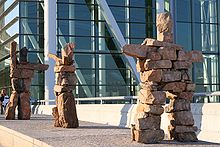 Inuksuk sculptures stand in front of the departures entrance at Terminal 1.
Inuksuk sculptures stand in front of the departures entrance at Terminal 1.
Terminal 2 was designed for three airlines: American Airlines, British Overseas Airways Corporation (BOAC), and Canadian Pacific Air Lines (CP Air). In the later development stages, it became apparent that it would not be viable in this form with the major complaints being the lack of indoor parking and the lack of windows. As American Airlines, British Airways (which BOAC became part of in 1974) and CP Air opted out of T2, Air Canada, as the government-owned airline, was forced to move its operations there despite objections. Initially, it was operated as three separate areas, befitting the three airlines for which it was designed: the western portion of the building, designed for CP, was the domestic zone; the centre section, designed for BA, was the international zone and the eastern portion, intended for AA, was the base for transborder flights. In the late 1970s, T2 was redesigned again; this iteration lasted until the acquisition of Canadian Airlines by Air Canada in 2000. The western zone remained Domestic, but was now colour-coded red. In the centre, a separate Rapidair area was created for flights to Ottawa Macdonald-Cartier International Airport and Montreal-Dorval International Airport, which was also red. The East section was the transborder area, coloured white. A new section was added on the east end for international flights and was coded blue. An airside corridor along the southern edge of T2 was added, giving access to and from Canada Customs; this made it possible for aircraft arriving in one zone to depart with passengers from another zone without regating the aircraft.
1984–present
An Emirates Airbus A380, the largest passenger aircraft in the world, connects Pearson with Dubai International Airport 3 times a week.[21]
The airport was renamed to Lester B. Pearson International Airport in 1984, in honour of Lester B. Pearson, the 14th Prime Minister of Canada and recipient of the Nobel Peace Prize. Operationally, the airport is often referred to as Toronto Pearson. Terminal 3 opened in 1991, to offset traffic from Terminal 1 and Terminal 2. Before its opening, Terminal 3 was the designation for the CP Air hangar at the airport during 1971 to handle the increased volume at Terminal 1.
There is one infield terminal located near the cargo tenants; however, it is not currently used for by any airline or cargo airline.
As part of the National Airports Policy, management responsibilities of the Toronto Pearson were transferred from Transport Canada to the Greater Toronto Airports Authority in 1996. The GTAA commenced a C$4.4 billion Airport Development Program with focus on terminal development, airside development, infield development, utilities and airport support facilities to occur over a 10-year period. Work began to replace Terminal 1 and Terminal 2 with a new Terminal 1, which along with a Terminal 3 would become the two passenger terminal facilities at Toronto Pearson.
To ensure the ability of Toronto Pearson to accommodate its growing aircraft volume, substantial redevelopment of the airside and infield systems took place. Cargo facilities were added in the centre of the airport between the parallel north–south runways, to increase capabilities and to offset the loss of the cargo facilities that were removed for the new terminal.[22] Two new runways were built to increase the number of aircraft that Toronto Pearson can process. A north–south runway, 15R/33L, was added and completed in 1997. Another east–west runway, 06R/24L, was completed in 2002.[23]
After the September 11 attacks, Toronto Pearson was part of Operation Yellow Ribbon, as it received 19 of the diverted flights that were coming into the United States, although Transport Canada and NAV CANADA instructed pilots to avoid the airport as a security measure.
The new Terminal 1 opened its piers D and E April 6, 2004. Previously, Terminal 2 had a facility for United States border preclearance and handled both domestic and international transborder traffic. Domestic traffic was moved to the new Terminal 1 when it became operational, leaving Terminal 2 to handle international traffic to the United States for Air Canada and its Star Alliance partner United Airlines.
Terminal 2 saw its last day in operation as a passenger terminal January 29, 2007, and airlines moved to the newly completed Pier F, or Hammerhead Pier at Terminal 1 the following day. Demolition of Terminal 2 began in April 2007 and concluded November 2008.[24] Terminal 1 was designed to easily accommodate a future expansion. Future projections expect Toronto Pearson to handle 55 million passengers annually by 2020,[citation needed] and Terminal 3 and 1 will also be expanded as needed to service the passengers.
The first landing of an A380 in Toronto was June 1, 2009, operated by Emirates.[21] Since then, the A380 operates on Monday, Wednesday and Friday from/to Dubai.
Traffic flow is steady at Pearson throughout the year, but during the day, peak passenger, cargo and aircraft movements are between 3:00 p.m. and 7:00 p.m. daily. Transpacific flights from East Asia peak late in the night, while Transatlantic flights peak during the afternoon. Flights from North America are available throughout the day, however, traffic from North America peaks during the morning hours.[25]
Terminals
Toronto Pearson International Airport currently has two operating terminals: Terminal 1 and Terminal 3. T1 opened April 6, 2004. The old Terminal 1, which closed simultaneously with the opening, was demolished to make room for additional gates at Pier E. Pier F at Terminal 1, which has an enlarged end called "Hammerhead F", opened January 30, 2007, to replace Terminal 2. This pier accommodates for international traffic and adds 7 million passengers per year to the airport's total capacity. Redevelopment of the airport was a logistical challenge as the existing terminals remained operational throughout construction and demolition.
Pearson is one of eight Canadian airports that has United States border preclearance facilities. U.S. Border Preclearance is located in both Terminal 1 and Terminal 3.
As of August 2010, free high speed Wi-Fi internet access is available throughout all passenger terminals at Toronto Pearson.[26]
Terminal 1
Terminal 1 is designed to handle domestic, international and transborder flights in one facility. The Terminal features three piers: Piers D and E with 38 gates and Pier F with 23 gates. Pier F serves transborder and international flights, replacing Terminal 2 and the Infield Terminal (IFT). A Pier G is slated to be built in the future if demand warrants.[27]
The terminal was designed by Skidmore, Owings and Merrill LLP, Adamson Associates Architects, and Moshe Safdie and Associates.
All Star Alliance airlines serving Toronto operate out of Terminal 1; however, the terminal is also used by airlines that are not members of Star Alliance. Terminal 1 has 58 gates: 101, 103, 105, 107–112, 120, 122, 124, 126, 128, 131–145, 151, 153, 155, 157, 160–163, 164A–164B, 165, 166A–166B, 167–181, 191 and 193. Two gates are able to handle the Airbus A380 aircraft. Currently Emirates is the only operator of this type into Toronto Pearson.
Measuring over 464,000 square metres (5,000,000 sq ft), Terminal 1 is the 11th largest airport terminal in the world in terms of floor area.
Along with the standard customs facilities, the terminal also contains a few customs "B" checkpoints along the international arrivals walkway. Passengers connecting from an international or trans-border arrival to another international (non-U.S.) departure in Terminal 1 go to one of these checkpoints for passport control and immigration checks and are then directed to Pier F. This alleviates the need to re-check bags and go through security and relieves congestion in the primary customs hall.[28]
The infield terminal was built to handle traffic displaced during the Terminal 1 development. The IFT has 11 gates (521 to 531). It is planned to be reactivated once passenger demand rises to a point in which Terminal 1 needs to be expanded again. It has also been used as a location for film and television shoots.
Terminal 3
Terminal 3, which opened February 21, 1991, was built to offset traffic from the old Terminal 1 and Terminal 2. Terminal 3 was initially advertised as "Trillium Terminal 3" and "The Trillium Terminal". It was built as a private venture and was a state of the art terminal containing, among other things, a U.S. customs pre-clearance facility. A parking garage and hotel is located across from the terminal and is connected to it by an elevated pedestrian walkway. At the time of opening, the hotel was managed by Swissôtel, it was rebranded a Sheraton property in October 1993.[29] In 1997 the GTAA purchased Terminal 3, shortly thereafter implementing a C$350 million expansion.[30]
The GTAA Terminal 3 Redevelopment Team (T3RD) was formed to oversee the terminal expansion.[31] In 2004, the Pier C Expansion opened. In June 2006, the East Processor Extension (EPE) started operations. With a soaring, undulating roofline, the EPE added 40 new check-in counters, new retail space, more secure 'hold-screening' for baggage and a huge picture window offering one of the most convenient apron viewing locations at the airport. Improved Canadian Border services and a more open arrivals hall were included in Phase I of the expansion. Phase II of the EPE has been completed in 2007 and includes larger security screening areas and additional international baggage claim areas. The West Processor Expansion Shell was completed by early 2008.[32]
Most Skyteam and Oneworld airlines serving Pearson operate out of Terminal 3, along with most airlines that are not affiliated with an airline alliance. Terminal 3 has 39 gates: A1–A6, B7–B22 and C24–C41.
Infrastructure and services
LINK Train
LINK Train 

Terminal 1 

Terminal 3 

GTAA Low Cost Parking (Viscount Station) Main article: LINK TrainIn July 2006, the automated LINK Train people mover opened, with two 6-car trains running between Terminals 1 and 3 and the 6A Station, where a reduced rate and airport staff parking lot exists between Airport Road and Viscount Road. A new parking garage, constructed at 6B parking lot, opposite the 6A Station and linked via a bridge across Viscount Road, opened in December 2009 with a capacity of 8,500 vehicles. This is a mixed-use building that accommodates long term parking, employee parking and rental car operations.
Tenants
- Peel Regional Police is the primary general police service at the airport. Airport Division is located on 2951 Convair Drive, on the south side of the airport near the Facilities Building along Highway 401.
- The Royal Canadian Mounted Police (RCMP) maintain a Toronto Airport Detachment to provide federal police services. The RCMP formerly provided policing at the airport. In December 2009, the RCMP was asked to help the Peel force in policing the airport due to the failed bombing incident at the Detroit airport. The Canada Border Services Agency as well as the Canadian Security Intelligence Service maintain extensive operations at the airport.
- The Greater Toronto Airports Authority administration offices are located on the south side of the airport. They were re-located when the original office was demolished to make way for the new Terminal 1's parking facilities.
- Esso Avitat – aviation fuel
- Shell Aerocentre – aviation fuel
- Skyservice Business Aviation
- Cara Operations – onboard food catering
Lounges
There are several airport lounges at Pearson Airport. Star Alliance, Skyteam, and Oneworld airlines all maintain lounges within the airport, and there are also several "Pay-In" lounges open for use by all passengers, regardless of airline, frequent flyer status or class of travel.
- Terminal 1
- Air Canada Maple Leaf Lounge (Star Alliance)[33]
- International (Level 3, Node F)
- International – USA (Level 4, Node F)
- Domestic
- Plaza Premium Lounge ("Pay-In" Lounge)[34]
- Domestic Departures (After security, on the right)
- International Departures (Next to Gate 177, take the elevator to Level 3)
- US Transborder (Near Gate 191)
- Terminal 3
- American Airlines Admirals Club (OneWorld)[35]
- British Airways The Galleries Club Lounge (OneWorld)[36]
- British Airways The Galleries First Lounge (OneWorld)[36]
- KLM Crown Lounge (Skyteam)[37]
- Plaza Premium Lounge ("Pay-In" Lounge)[38]
- Domestic Departures (Between Gate B23 and C24)
- International Departures (Next to Gate C32, take the elevator to the AT level)
United States border preclearance
Main article: United States border preclearanceUnited States border preclearance was invented at Pearson in 1952 as a convenience to allow it to connect as a domestic airport to the many American airports that, at that time, lacked customs halls. It was at first a service performed by agents at the gate. American concerns over smuggling between precleared and non-cleared passengers (who originally shared mixed terminal space) nearly ended the program in the 1970s until a compromise was reached that called for segregated facilities. Today Pearson handles 8 million passengers through preclearance, one quarter of all passenger traffic. As a result Pearson terminals have an unusual bipartite configuration that physically separates transborder from domestic and international passengers from check-in through to boarding. One unintended consequence of this is a more limited selection of retail shops after passing through security, as outgoing transborder passengers cannot use the same airport shops as other passengers (terminal corridors are often separated by a glass partition), reducing the potential customer base for shops by 25%; this results in fewer large shops and restaurants compared to peer airports, and more duplicates of convenience-oriented retail.
Airlines and destinations
Scheduled airlines and destinations
Airline Destinations Terminal Aerosvit Airlines Kiev-Boryspil 3 Air Canada Antigua, Aruba, Barbados, Beijing-Capital, Bermuda, Bogotá, Boston, Brussels, Buenos Aires-Ezeiza, Calgary, Cancún, Caracas, Cayo Coco/Cayo Guillermo, Chicago-O'Hare, Copenhagen, Cozumel, Deer Lake, Denver, Edmonton, Fort Lauderdale, Fort McMurray, Fort Myers, Frankfurt, Geneva, George Town/Exuma, Grand Cayman, Halifax, Havana, Holguin, Hong Kong, Ixtapa/Zihuatanejo, Kelowna, Kingston (Jamaica), Las Vegas, Lima, London-Heathrow, Los Angeles, Mexico City, Miami, Montego Bay, Montréal-Trudeau, Munich, Nassau, New York-LaGuardia, Newark, Orlando, Ottawa, Paris-Charles de Gaulle, Philadelphia, Phoenix, Portland (OR), Providenciales, Puerto Plata, Puerto Vallarta/Riviera Nayarit, Punta Cana, Regina, St. John's (NL), St. Lucia, Samaná, San Diego, San Francisco, San José de Costa Rica, Santa Clara (Cuba), Santiago de Chile, São Paulo-Guarulhos, Saskatoon, Seattle/Tacoma, Seoul-Incheon, Shanghai-Pudong, Sydney (Australia), Tampa, Tel Aviv-Ben Gurion, Tokyo-Narita, Vancouver, Varadero, Victoria (BC), Washington-National, Winnipeg, Zürich
Seasonal: Athens, Barcelona, Cayo Largo del Sur, Curaçao [begins December 24], Dublin, Gander (NL), Grenada, La Romana, Liberia (Costa Rica), Madrid, Rome-Fiumicino, St. Kitts [begins December 23], St. Maarten, St. Thomas [begins December 24], San José del Cabo, San Juan, Sarasota/Bradenton, West Palm Beach1 Air Canada Express operated by Air Georgian Albany (NY), Allentown/Bethlehem, Detroit, Grand Rapids (MI), Harrisburg, Hartford, Kingston (ON), Portland (ME), Providence, Rochester (NY), Richmond (VA), Sarnia, Syracuse (NY) 1 Air Canada Express operated by Jazz Air Atlanta, Baltimore, Boston, Charlotte, Charlottetown, Chicago-O'Hare, Cincinnati/Northern Kentucky, Cleveland, Columbus (OH), Dallas/Fort Worth, Detroit, Fredericton, Hartford, Houston-Intercontinental, Indianapolis, Kansas City, Kingston (ON), London (ON), Memphis, Milwaukee, Minneapolis/St. Paul, Moncton, Montréal-Trudeau, Nashville, Newark, New Orleans, North Bay, Ottawa, Pittsburgh, Québec City, Raleigh/Durham, Richmond (VA), Saint John (NB), St. Louis, Sault Ste. Marie, Sudbury, Sydney (NS), Thunder Bay, Timmins, Windsor 1 Air France Paris-Charles de Gaulle 3 Air India Amritsar, Delhi 1 Air Transat Amsterdam, Athens, Barcelona, Cancún, Dublin, Faro, Glasgow-International, Lisbon, London-Gatwick, Manchester (UK), Montego Bay, Montréal-Trudeau, Orlando, Paris-Charles de Gaulle, Porto, Punta Cana, Québec City, Rome-Fiumicino, Santa Clara (Cuba), Varadero
Seasonal: Antigua [begins December 24], Aruba, Birmingham (UK), Camaguey, Cayo Coco/Cayo Guillermo, Exeter, Fort Lauderdale, Frankfurt, Hamburg, Istanbul-Atatürk, Lamezia Terme, La Romana, London-Heathrow, Lyon, Madrid, Málaga, Marseille, Munich, Nantes, Newcastle upon Tyne, Panama City, Pescara, Ponta Delgada, Port of Spain, Puerto Plata, Puerto Vallarta/Riviera Nayarit, St. Lucia, St. Maarten, Samaná [begins November 21], San José de Costa Rica, San Salvador, Shannon, Terceira, Venice-Marco Polo, Vienna3 Alitalia Rome-Fiumicino 3 American Airlines Dallas/Fort Worth, Los Angeles, Miami
Seasonal: Chicago-O'Hare3 American Eagle Chicago-O'Hare, New York-JFK, New York-LaGuardia 3 Arkefly Seasonal: Amsterdam 1 Austrian Airlines Vienna 1 British Airways London-Heathrow 3 Caribbean Airlines Grenada [begins December 15], Kingston (Jamaica), Port of Spain 3 Cathay Pacific Hong Kong 3 Condor Flugdienst Seasonal: Frankfurt [begins June 22, 2012] 3 Continental Connection operated by CommutAir Cleveland 1 Continental Connection operated by Colgan Air Newark 1 Continental Express operated by ExpressJet Airlines Cleveland, Houston-Intercontinental, Newark 1 Copa Airlines Panama City 1 Cubana de Aviación Camaguey, Cienfuegos, Havana, Holguin, Varadero 3 Delta Connection operated by Atlantic Southeast Airlines Atlanta, Detroit 3 Delta Connection operated by Comair Cincinnati/Northern Kentucky, Detroit, Minneapolis/St. Paul 3 Delta Connection operated by Compass Airlines Atlanta, Detroit 3 Delta Connection operated by Mesaba Airlines New York-JFK 3 Delta Connection operated by Pinnacle Airlines Atlanta, Boston, Cincinnati/Northern Kentucky, Detroit, Minneapolis/St. Paul, New York-JFK 3 El Al Tel Aviv-Ben Gurion 3 Emirates Dubai 1 Etihad Airways Abu Dhabi 1 EVA Air Taipei-Taoyuan 3 Finnair Seasonal: Helsinki 3 Hainan Airlines Beijing-Capital 3 Icelandair Reykjavík-Keflavík 3 Jet Airways Brussels, Delhi 1 KLM Amsterdam 3 Korean Air Seoul-Incheon 3 LOT Polish Airlines Warsaw 1 Lufthansa Düsseldorf, Frankfurt 1 Pakistan International Airlines Islamabad, Karachi, Lahore 3 SATA International Lisbon, Ponta Delgada, Porto, Terceira 3 Sunwing Airlines Cancún, Cayo Coco/Cayo Guillermo, Grenada, Halifax, Holguin, Las Vegas, Mazatlan, Montego Bay, Orlando, Panama City, Port of Spain, Puerto Plata, Puerto Vallarta/Riviera Nayarit, Punta Cana, San Jose del Cabo, Santa Clara (Cuba), St. Petersburg/Clearwater, Varadero
Seasonal: Acapulco, Amsterdam, Aruba, Barbados, Cozumel, Camaguey, Cienfuegos, Fort Lauderdale, Gander (NL), Huatulco, Ixtapa/Zihuatanejo, Kingston (Jamaica), La Romana, Liberia (Costa Rica), Lisbon, London-Gatwick, Manzanillo de Cuba, Mexico City, Nassau, Paris-Charles de Gaulle, Porto, Roatán, Rome-Fiumicino, San Juan, St. Maarten, Santiago de Cuba, Stephenville, Vancouver1 TACA Airlines San Salvador 3 TACA Airlines operated by Lacsa San José de Costa Rica 3 Transaero Moscow-Domodedovo 3 Turkish Airlines Istanbul-Atatürk 1 United Airlines Chicago-O'Hare, San Francisco 1 United Express operated by ExpressJet Airlines Washington-Dulles 1 United Express operated by GoJet Airlines Chicago-O'Hare, Washington-Dulles 1 United Express operated by Shuttle America Chicago O'Hare, Denver, Washington-Dulles 1 United Express operated by SkyWest Airlines Houston-Intercontinental, Washington-Dulles 1 US Airways Express operated by Air Wisconsin Charlotte, Philadelphia 1 US Airways Express operated by Republic Airlines Charlotte, Philadelphia 1 WestJet Barbados, Bermuda, Calgary, Cancún, Cayo Coco/Cayo Guillermo, Charlottetown, Edmonton, Fort Lauderdale, Fort Myers, Grand Cayman, Halifax, Kelowna, Las Vegas, Miami, Moncton, Montego Bay, Montréal-Trudeau, Nassau, Orlando, Ottawa, Providenciales, Puerto Plata, Puerto Vallarta/Riviera Nayarit, Punta Cana, Québec City, Regina, St. John's (NL), St. Lucia, St. Maarten, Samaná, Saskatoon, Tampa, Thunder Bay, Vancouver, Varadero, Winnipeg
Seasonal: Cozumel, Deer Lake, Freeport, Fort McMurray, Holguin, La Romana, Palm Springs, San Juan, Santa Clara (Cuba), Sydney (NS), Victoria (BC)3 Charter airlines and destinations
Airlines Destinations Terminal CanJet Camaguey, Cancún, Cayo Coco/Cayo Guillermo, Cayo Largo del Sur, Fort Lauderdale, Holguin, Montego Bay, Montréal-Trudeau, Orlando, Panama City, Puerto Plata, Puerto Vallarta/Riviera Nayarit, Punta Cana, Santa Clara (Cuba), Santiago de Cuba, St. Lucia, St. Maarten, St. Petersburg/Clearwater [begins December 24], Varadero
Seasonal: Acapulco, Antigua, Aruba, Barbados [begins December 18], Cartagena, Cozumel [begins December 23], Ixtapa/Zihuatajeto, Liberia (Costa Rica), Manzanillo [begins December 19], Porlamar, Samana, San Jose de Costa Rica [begins December 22], San Salvador, Santo Domingo [begins December 20]3 Enerjet Seasonal: Cancún, Curaçao, Georgetown, Liberia (Costa Rica), Montego Bay, Puerto Plata, Puerto Vallarta/Riviera Nayarit, Punta Cana, Varadero 3 Miami Air International Orlando 3 Sky King Atlantic City 3 Thomas Cook Airlines London-Gatwick, Manchester 3 Thomas Cook Canada operated by Jazz Aviation LP Seasonal: Aruba, Cancún, Cartagena [begins December 19], Cozumel, Curaçao, Fort Lauderdale [begins December 24], Holguin [begins December 22], La Romana [begins December 23], Liberia (Costa Rica), Montego Bay, Nassau, Puerto Plata, Puerto Vallarta/Riviera Nayarit, Punta Cana, Samana [begins December 23], San Jose del Cabo, Varadero [begins December 22] 3 WestJet Aruba, Liberia (Costa Rica), San Jose del Cabo 3 Cargo operations
There are two main cargo facilities at Pearson.[39] The Cargo West Facilities are located between runways 15L/33R and 15R/33L, and the Cargo Area 5 or VISTA Cargo Centres Incorporated are located north of Terminal 3. Also, FedEx Express Canada Cargo occupy facilities at west side of airport near runway 05/23. An additional separate cargo area is located north of the aviation facilities.
Tenants using the Cargo West Facilities Air Canada Cargo American Airlines BAX Global CBSA Worldwide Flight Services Inc Tenants using the Cargo Area 5/VISTA Cargo Centre Air Canada AccessAir ACE Freight Air France Cargo Airline Cargo Sales Air-Ship International Air Time Express Alitalia All Trade Shipping American Aviation Parts & Service Airport Terminal Services Austrian Airlines Canada Border Services Agency Canada Post Cargolux[40] Cargo Sales Resources Cargo Zone Cargoitalia CAS Cargo and Travel Cathay Pacific Delta Air Lines DHL Express El Al EVA Air Excel Cargo Exp-Air Cargo Freight Systems Incorporated Air India Handlex Incorporated International Cargo International Fastline Forwarding Japan Airlines KLM Cargo Korean Air LAN Chile LOT Polish Airlines Lufthansa Cargo Mayfield Cargo Finnair Onward Transportation Orbit Brokers SATA Cargo Pine Tree Express Platinum Air Cargo Prestige International Qatar Airways Cargo[41] Secure Maple Freight Swiss International Airlines Swissport Turkish Cargo TBI U Freight International UPS Airlines Varig Logistics VCC Cargo Services Tenants using the cargo area north of the aviation facilities Shell Aerocentre Hangars and Flight Lounge All Cargo Airlines Ltd Air 500 Access
Motor vehicle
The airport is accessible from Highway 427 (just north of the Highway 401 interchange) or from Highway 409, a spur off Highway 401 leading directly into the airport. Airport Road to the north and Dixon Road to the east both provide local access to the airport.[42]
Restricted road access from Courtney Park Drive and Britannia Road to the west side of the airport are for authorized vehicles only. Various roads to the cargo area to the north are also restricted. Other roads that travel along the airport grounds and runways are blocked off by fencing and gates.
Public transit
Bus services connecting Toronto and the surrounding region to Pearson Airport include the Toronto Transit Commission (public transit), GO Transit (public regional transit), MiWay (public transit), Brampton Transit (public transit), Toronto Airport Express Coach (private airport coach service), and Can-ar Coach Service (private airport coach service):[43]
Route Destination Service Times Terminals Served Schedule Toronto Transit Commission (TTC) 192 Airport Rocket Express service to Kipling Station on the All-day 1 and 3 [44] 58A/58D Malton Local service to Lawrence West Station on the Yonge–University–Spadina Subway Line
All-day 1 and 3 [45] 300A Bloor-Danforth Local service along Bloor Street and Danforth Avenue to Warden Avenue Overnight (approximately 2:00 a.m.–6:00 a.m. daily)
1 and 3 [46] 307 Eglinton West Local service along Eglinton Avenue West to Yonge Street Overnight (approximately 2:00 a.m.–6:00 a.m. daily)
1 and 3 [47] GO Transit 34 Brampton Local Eastbound: Semi-express service to York Mills and Yorkdale TTC subway stations on the Yonge–University–Spadina Subway Line
Westbound: Local service to Brampton and Bramalea bus terminals
All-day 1 only [48] 40 Pearson Airport Express service to Richmond Hill Centre bus terminal. All-day 1 only [49] MiWay 7 Airport Local service to: Southbound: Square One. Northbound: Westwood Mall.
All-day 1 only [50] 107 Malton Express Express service to: Southbound: Square One. Northbound: Westwood Mall.
Access from the airport's offsite parking is made via Viscount LINK Station.
This route will become one of the branches of Mississauga's BRT system.
Rush hour Viscount LINK Station [50] 57 Courtneypark Local service from the airport's Infield Cargo area to: Northbound: Meadowvale Town Centre
Southbound: Islington Station on the Bloor–Danforth Subway Line
Rush hour None [50] 59 Infield Local service from Westwood Mall to the airport's Infield Cargo area One trip daily None [50] Brampton Transit 115 Airport Express Semi-express service to Bramalea bus terminal All-day 1 only [51] Toronto Airport Express Coach Pacific Western Transportation operates airport shuttle coach buses between downtown locations and Pearson Airport under the Toronto Airport Express brand. All-day 1 and 3 [52] Can-ar Coach Service Operates a once-a-day coach service to Port Elgin, Ontario, serving communities in Dufferin, Grey, and Bruce counties. [2] Taxis, limousines, and shuttle vehicles
Toronto Pearson International Airport has pick-up locations for taxis, limousines, out-of-town bus and/or shuttle services, offering transportation to downtown Toronto, cities throughout Ontario, and into Detroit. Taxis are licensed by the City of Mississauga, separately from the City of Toronto. Taxis licensed in Toronto can deliver to Pearson, but only airport-licensed taxis and limos can pickup at Pearson legally. One can also pre-arrange one's ride by GTA Airport Taxi or GTA Airport Limo at the Airport; one's ride will be waiting for one at the Pearson Airport. It is a little procedure one has to follow for pre-arrange reservation.[53] Pearson Airport Limousine companies use GTAA authorized out of town flat rates for pickups from Pearson Airport.[54]
Toronto Pearson International Airport supports many out-of-town small bus, van and shuttle operators, offering transportation from the airport to cities, towns, and villages throughout Southern Ontario. Some operators offer connections to other airports in Ontario (John C. Munro Hamilton International Airport in Hamilton and London International Airport in London) or in the United States (Detroit Metropolitan Wayne County Airport in Detroit, Michigan and Buffalo Niagara International Airport in Buffalo, New York).[55]
Future expansion
Further information: Air Rail Link, Eglinton–Scarborough Crosstown line, and Mississauga TransitwayThe airport is not currently served by trains, even though it is near an existing railway line. In July 2010, Metrolinx, Toronto's regional transport agency, announced it would design, build, own, and operate a commuter rail-style airport rail link from Union Station. Construction has begun and is expected to be completed in time for the 2015 Pan American Games.[56] The service is expected to eliminate 1.5 million car trips annually. The project, whose cost is estimated at $300–500 million, remains controversial due to opposition from neighbourhoods along the route. Currently the closest rail station from Pearson is Malton GO Station at Derry Road east of Airport Road. There is no direct access or connections from this station to the airport.
The originally proposed Eglinton Crosstown LRT was projected to connect Pearson to Scarborough by 2018 as part of the Transit City plan.[57] However, Toronto Mayor Rob Ford announced the cancellation of Transit City on the day that he took office.[58] The redesigned Eglinton–Scarborough Crosstown line was announced four months later. It would include the Scarborough RT, but the line will terminate at Black Creek Drive instead of connecting to the airport.[59] A future extension could eventually reach the airport, completing the line as originally envisioned, but this has not yet been discussed and is not a near-term possibility.
One of the routes in GO Transit's proposed Highway 407 BRT system would reach the airport. As a precursor, GO currently operates the 40 Airport Express route between Richmond Hill Centre and Pearson Airport. This route formerly served Mississauga City Centre, but was shortened due to MiWay's launch of its own Airport Express route. The second BRT route would utilize the Highway 403 Transitway, which is currently under construction. Mississauga Transit's 107 Malton Express is in service since March 2010, connecting Mississauga City Centre, Malton, and Pearson Airport via the LINK Train's Viscount Station during peak hours only. After the completion of the transitway in late 2012, travel times between these destinations would be cut down to 19 minutes (compared to 7 Airport's 41 minutes and to the current 107's 29 minutes). Also, an all-day, all-week connection between the two destinations would be established. However, it is not known whether the route would enter the airport proper when Route 107 becomes a fully established BRT route and when full BRT service commences.[60]
Accidents and incidents
- On November 3, 1959, Vickers Viscount CF-TGY of Trans-Canada Air Lines was written off when it landed short of the runway[61]
- On June 13, 1964, Vickers Viscount CF-THT of Air Canada was damaged beyond economical repair when it crash-landed after the failure of two engines on approach.[62]
- The airport's deadliest accident occurred on July 5, 1970, when Air Canada Flight 621, a DC-8 jet, flew on a Montreal–Toronto–Los Angeles route. The pilots inadvertently deployed spoilers before the plane attempted landing, forcing the pilots to abort landing and takeoff. Damage to the aircraft caused during the failed landing attempt caused the plane to break up in the air during the go-around, killing all 100 passengers and nine crew on board when it crashed in a field southeast of Brampton. Controversy remains over the cleanup effort following the crash, as both plane wreckage debris and human remains from the crash are still found on the site.[63]
- On 30 August 1970, Douglas C-47 CF-JRY of D G Harris Productions was damaged beyond economic repair in a storm.[64]
- On June 26, 1978, Air Canada Flight 189 to Winnipeg overran the runway during an aborted takeoff, and crashed into the Etobicoke Creek ravine. Two of 107 passengers on board the DC-9 were killed.
- 1983: Air Canada Flight 797, on a Dallas–Toronto–Montreal route, had an in-flight fire and landed in Cincinnati; half of the occupants died, including famed Canadian folksinger, Stan Rogers.
- On June 22, 1983, Douglas C-47A C-GUBT of Skycraft Air Transport crashed on approach to Toronto International Airport while on an international cargo flight from Cleveland Hopkins International Airport, Ohio. Both crew were killed.[65]
- 1985: A bomb was loaded onto Air India Flight 181, which departed from Toronto Pearson International Airport and arrived at Montréal-Mirabel International Airport and then departed as Air India Flight 182, using the same aircraft and carrying passengers who were on Flight 181, was scheduled to fly on the Montreal–London–Delhi–Bombay route. The Boeing 747-200B exploded over the Atlantic Ocean off the coast of Cork, Ireland killing all 307 passengers and 22 crew.
- 2001: Air Transat Flight 236, flying from Toronto Pearson to Lisbon Portela Airport in Lisbon, Portugal with 306 people on board, ran out of fuel over the Atlantic Ocean. The aircraft was forced to make an emergency landing at Lajes Field in the Azores. There were no fatalities and only minor injuries.
- On August 2, 2005, Air France Flight 358, an Airbus A340-300 (registration F-GLZQ) inbound from Paris, landed on runway 24L in a severe thunderstorm, failed to stop and ran off the runway into the Etobicoke Creek ravine. The rear third of the plane burst into flames, eventually engulfing the whole plane except the cockpit and wings. There were 12 serious injuries and no fatalities. The investigation predominately blamed pilot error when faced with the severe weather conditions.
- 2010: Pakistan International Airlines Flight 782, en route from Toronto Pearson International Airport to Jinnah International Airport in Karachi, Pakistan made an emergency landing at Arlanda Airport in Stockholm, Sweden on September 25 due to a hoax bomb threat on board. After evacuating all 273 passengers from the Boeing 777-200LR aircraft, a thorough police search was conducted to find any explosives on the aircraft. No explosives were found during the investigation and the plane arrived at Karachi 13 hours late.[66]
See also
References
- ^ Canada Flight Supplement. Effective 0901Z 20 October 2011 to 0901Z 15 December 2011
- ^ "Synoptic/Metstat Station Information". http://climate.weatheroffice.gc.ca/prods_servs/metstat1_e.html. Retrieved 2011-05-15.
- ^ "Airport Divestiture Status Report". Tc.gc.ca. 2011-01-12. http://www.tc.gc.ca/programs/Airports/Status/menu.htm. Retrieved 2011-02-19.
- ^ a b c "Total aircraft movements by class of operation — NAV CANADA towers". Statcan.gc.ca. http://www.statcan.gc.ca/pub/51-209-x/2011001/t002-eng.htm. Retrieved 2011-05-28.
- ^ a b Airport Traffic Reports
- ^ 2006 Census: Portrait of the Canadian Population in 2006: Findings Statistics Canada 2006
- ^ "GTAA – Toronto Pearson today". Gtaa.com. http://www.gtaa.com/en/news/torontopearson_today/details/cb97a4d2-351d-43fc-a2b4-7a188b1210fa. Retrieved 2011-02-19.
- ^ 2009 Passenger Statistics[dead link]
- ^ Greater Toronto Airport Authority – Toronto Pearson Voted "Best Global Airport 2006" by the Institute of Transport Management – Oct 30, 2006
- ^ "Toronto Pearson ON (YYZ)". Staralliance.com. http://www.staralliance.com/en/services/destination-information/airport/yyz/. Retrieved 2011-02-19.
- ^ "Vancouver BC (YVR)". Staralliance.com. http://www.staralliance.com/en/services/destination-information/airport/yvr/. Retrieved 2011-02-19.
- ^ "Montreal Trudeau QC (YUL)". Staralliance.com. http://www.staralliance.com/en/services/destination-information/airport/yul/. Retrieved 2011-02-19.
- ^ "Calgary AB (YYC)". Staralliance.com. http://www.staralliance.com/en/services/destination-information/airport/yyc/. Retrieved 2011-02-19.
- ^ Airports in the national airports category[dead link]
- ^ "Greater Toronto Airports Authority – Destinations". Gtaa.com. http://www.gtaa.com/en/travellers/airport_information/airlines_and_destina/destinations/. Retrieved 2010-03-11.
- ^ "GTAA". Torontolandingfees.com. http://www.gtaa.com/en/travellers/airport_information/airlines_and_destina/. Retrieved 2010-03-11.
- ^ "City of Toronto Archives: Toronto history FAQs". Toronto.ca. http://www.toronto.ca/archives/toronto_history_faqs.htm#pearson. Retrieved 2010-03-11.
- ^ "Flight Ontario – BCATP Schools". Flightontario.com. http://www.flightontario.com/bcatp-schools.htm. Retrieved 2011-02-19.
- ^ "Toronto Port Authority". Torontoport.com. http://www.torontoport.com/airport_history.asp. Retrieved 2010-03-11.
- ^ "GTAA Master Plan". p. 1.19. http://www.torontopearson.com/uploadedFiles/GTAA/Content/About_GTAA/Strategy/Master_Plan/MP%20-%20Chapter%201%20-%20Introduction.pdf.
- ^ a b Staff reporter (2009-06-01). "World's largest jetliner touches down in Toronto". CBC News. http://www.cbc.ca/canada/toronto/story/2009/06/01/jetliner-a380-pearson.html. Retrieved 2009-07-04.
- ^ "GTAA – Chapter 4:Layout 1" (PDF). http://gtaa.com/local/files/en/Corporate/Publications/MasterPlan-2008/MP%20-%20Chapter%204%20-%20Airport%20Development%20Program.pdf. Retrieved 2011-02-19.
- ^ "GTAA – Chapter 5:Layout 1" (PDF). http://gtaa.com/local/files/en/Corporate/Publications/MasterPlan-2008/MP%20-%20Chapter%205%20-%20The%20Airside%20System.pdf. Retrieved 2011-02-19.
- ^ "CTV News". Ctv.ca. http://www.ctv.ca/servlet/HTMLTemplate?tf=/ctv/mar/video/new_player.html&cf=ctv/mar/ctv.cfg&hub=TorontoHome&video_link_high=mms://ctvbroadcast.ctv.ca/video/2006/11/30/ctvvideologger1_500kbit/s_2006_11_30_1164930775.wmv&video_link_low=mms://ctvbroadcast.ctv.ca/video/2006/11/30/ctvvideologger1_218kbit/s_2006_11_30_1164929527.wmv&clip_start=00:06:11.27&clip_end=00:01:39.09&clip_caption=Janice%20Golding%20previews%20Pearson%E2%80%99s%20new%20Terminal%201&clip_id=ctvnews.20061130.00172000-00172950-clip1&subhub=video&no_ads=&sortdate=20061130&slug=pearson_terminal_one_061130&archive=CTVNews. Retrieved 2011-02-19.
- ^ "Greater Toronto Airports Authority – Live Flight Information". Gtaa.com. http://www.gtaa.com/en/travellers/search_results/?info=arrivals&all=true&submitting=true. Retrieved 2011-05-15.
- ^ http://www.thestar.com/travel/northamerica/article/843848--free-wi-fi-begins-at-toronto-pearson-airport
- ^ Schwartz, Adele C. (2005-12-01). "Changes to Toronto's Terminal 1 design improve passenger flow and visibility, adds handling space". Atwonline.com. http://www.atwonline.com/magazine/article.html?articleID=1472. Retrieved 2011-02-19.
- ^ airport wayfinder
- ^ "Sheraton takes over Swissotel, increases Metro hotels to 4". Toronto Star (Torstar Corp.): p. F7. 1993-10-08. http://pqasb.pqarchiver.com/thestar/access/518981991.html?FMT=ABS&FMTS=ABS:FT&type=current&date=Oct+08%2C+1993&author=&pub=Toronto+Star&edition=&startpage=F.7&desc=Sheraton+takes+over+Swissotel%2C+increases+Metro+hotels+to+4. Retrieved 2010-09-22.
- ^ Joan Bryden (1997-04-02). "Settlement near over cancelled airport contract". Toronto Star (Torstar Corp.): p. B3. http://pqasb.pqarchiver.com/thestar/access/508524041.html?FMT=ABS&FMTS=ABS:FT&date=Apr+2%2C+1997&author=Joan+Bryden&pub=The+Spectator&edition=&startpage=B.3&desc=Settlement+near+over+cancelled+airport+contract. Retrieved 2010-09-22.
- ^ "march-april.qxp" (PDF). http://www.gtaa.com/local/files/en/TodayMarApr2006.pdf. Retrieved 2011-02-19.
- ^ WestJet has over 22 destinations from this terminal, with an average of 100+ flights daily, making it one of the busier airlines serving the airport Toronto Pearson Today July–August
- ^ "Travel Info – Maple Leaf Lounges". aircanada.com. 2008-11-24. http://www.aircanada.com/en/travelinfo/airport/maplelounges/locations.html. Retrieved 2010-03-11.
- ^ "Plaza Premium Lounge – Toronto". Plaza-network.com. http://www.plaza-network.com/index.php/locations/toronto. Retrieved 2011-02-19.
- ^ "Admirals Club Airport Lounges". Aa.com. 2009-03-31. http://www.aa.com/i18n/amrcorp/newsroom/admirals-club-airport-lounges.jsp. Retrieved 2010-03-11.
- ^ a b "Lounge locations". British Airways. http://www.britishairways.com/travel/ecbenftloungelist/public/en_gb. Retrieved 2010-03-11.
- ^ "Locations of the KLM Crown Lounge". KLM.com. http://www.klm.com/travel/no_en/travel_information/at_the_airport/lounges/locations_crown_lounges.htm. Retrieved 2010-03-11.
- ^ http://www.plaza-people.com/yyz_en/DocT3.aspx
- ^ "Cargo Services". Greater Toronto Airports Authority. 2007. http://www.gtaa.com/en/business_at_pearson/cargo_services. Retrieved 2009-07-04.
- ^ "Greater Toronto Airports Authority – Toronto Pearson Today". Gtaa.com. 2009-04-20. http://www.gtaa.com/en/news/torontopearson_today/details/e33784e6-7f12-4f78-8ead-80978ccc50d4. Retrieved 2010-03-11.
- ^ http://www.aircargoworld.com/Air-Cargo-News/2011/10/qatar-airways-cargo-announces-north-american-expansion-plan/102550
- ^ "Greater Toronto Airports Authority – Driving Directions". Gtaa.com. http://www.gtaa.com/en/travellers/airport_information/ground_transportatio/driving_directions/. Retrieved 2010-03-11.
- ^ "Greater Toronto Airports Authority – Public Transportation". Gtaa.com. http://www.gtaa.com/en/travellers/airport_information/ground_transportatio/public_transportatio/. Retrieved 2010-03-11.
- ^ "TTC 192 Airport Rocket Northbound". .ttc.ca. 2011-01-27. http://www3.ttc.ca/Routes/192/Northbound.jsp. Retrieved 2011-02-19.
- ^ "TTC 58 Malton Eastbound". .ttc.ca. 2010-07-30. http://www3.ttc.ca/Routes/58/Eastbound.jsp. Retrieved 2011-02-19.
- ^ "TTC 300 Bloor – Danforth Eastbound". 2011-01-27. http://www3.ttc.ca/Routes/300/Eastbound.jsp. Retrieved 2011-02-19.
- ^ "TTC 307 Eglinton West Eastbound". .ttc.ca. http://www3.ttc.ca/Routes/307/Eastbound.jsp. Retrieved 2011-02-19.
- ^ "Schedule selected". GOTransit.com. http://gotransit.com/publicroot/en/schedules/lstserdt.aspx?table=34. Retrieved 2011-02-19.
- ^ "Schedule selected". GOTransit.com. http://gotransit.com/publicroot/en/schedules/lstserdt.aspx?table=40. Retrieved 2011-02-19.
- ^ a b c d "Residents – MiWay – The New Mississauga Transit". Mississauga.ca. http://www.mississauga.ca/portal/residents/publictransit. Retrieved 2011-02-19.
- ^ http://www.brampton.ca/en/residents/transit/Schedules-Maps/Documents/Sep20_2010/101_print_3.pdf
- ^ "Service Info – Schedule: Airport Express". Torontoairportexpress.com. http://www.torontoairportexpress.com/schedule.php. Retrieved 2011-02-19.
- ^ "Greater Toronto Airports Authority – Taxis & Limousines". Gtaa.com. 2009-08-01. http://www.torontopearson.com/en/toandfrom/taxilimo/. Retrieved 2011-08-11.
- ^ [1]
- ^ "Greater Toronto Airports Authority – Out-of-Town Van Services". Gtaa.com. http://gtaa.com/en/travellers/airport_information/ground_transportatio/outoftown_van_servic/. Retrieved 2010-03-11.
- ^ "Railway Gazette: Toronto airport rail link negotiations collapse". http://www.railwaygazette.com/news/single-view/view/10/toronto-airport-rail-link-negotiations-collapse/browse/5.html. Retrieved 2010-08-16.
- ^ "Commission Report Macro" (PDF). http://www3.ttc.ca/About_the_TTC/Commission_reports_and_information/Commission_meetings/2009/November_17_2009/Reports/Eglinton_Crosstown_L.pdf. Retrieved 2010-03-11.
- ^ Mayor Rob Ford: “Transit City is over” Toronto Life December 1, 2010
- ^ "Funding questions linger after new transit plan announced" By Natalie Alcoba, National Post. March 31, 2011
- ^ http://www.mississauga.ca/file/COM/BRTnewsletterFall09.pdf
- ^ "Accident description". Aviation Safety Network. http://aviation-safety.net/database/record.php?id=19590013-0. Retrieved 7 September 2009.
- ^ "Accident description". Aviation Safety Network. http://aviation-safety.net/database/record.php?id=19640613-1. Retrieved 6 October 2009.
- ^ Wilkes, Jim (July 6, 2004) "Ghosts of Flight 621 haunt Brampton field", Toronto Star. Retrieved July 6, 2007.
- ^ "CF-JRY Hull-loss description". Aviation Safety Network. http://aviation-safety.net/database/record.php?id=19700830-0. Retrieved 20 October 2010.
- ^ "C-GUBT Accident report". Aviation Safety Network. http://aviation-safety.net/database/record.php?id=19830622-0. Retrieved 27 July 2010.
- ^ "Canada to Pakistan flight grounded in Europe after bomb threat". Digitaljournal.com. http://www.digitaljournal.com/article/298085. Retrieved 2011-05-15.
External links
- Toronto Pearson International Airport – Greater Toronto Airports Authority
- Airport Wayfinder: Interactive video guide and detailed informations about Toronto-Pearson International Airport.
- Past three hours METARs, SPECI and current TAFs for Toronto Pearson International Airport from NAV CANADA as available.
Airports in Ontario with Scheduled Flights Major Hamilton Munro · London · Ottawa Macdonald-Cartier · Sault Ste. Marie · Sudbury · Thunder Bay · Toronto Billy Bishop · Toronto Pearson · Windsor · WaterlooMinor Attawapiskat · Big Trout Lake · Cat Lake · Deer Lake · Dryden Regional · Fort Albany · Fort Frances Municipal · Fort Hope · Fort Severn · Kapuskasing · Kasabonika · Kashechewan · Keewaywin · Kenora · Kingfisher Lake · Kingston/Norman Rogers · Lansdowne House · Moosonee · Muskrat Dam · North Bay/Jack Garland · North Spirit Lake · Peawanuck · Pickle Lake · Pikangikum · Poplar Hill · Red Lake · Round Lake (Weagamow Lake) · Sachigo Lake · Sandy Lake · Sarnia (Chris Hadfield) · Sioux Lookout · Summer Beaver · Timmins · Toronto/Buttonville Municipal Airport · Webequie · Wunnummin LakeAirports in Canada By name A–B · C–D · E–G · H–K · L–M · N–Q · R–S · T–ZBy location indicator CA · CB · CC · CD · CE · CF · CG · CH · CI · CJ · CK · CL · CM · CN · CO · CP · CR · CS · CT · CV · CW · CY · CZBy province/territory National Airports System Calgary · Charlottetown · Edmonton · Fredericton · Gander · Halifax · Iqaluit · Kelowna · London · Moncton · Montréal-Mirabel · Montréal-Trudeau · Ottawa · Prince George · Québec · Regina · Saint John · St. John's · Saskatoon · Thunder Bay · Toronto · Vancouver · Victoria · Whitehorse · Winnipeg · YellowknifeRelated List of airports by ICAO code: C · List of defunct airports in Canada · List of heliports in Canada · List of international airports in Canada · National Airports System · Operation Yellow RibbonFedEx Corporation Established 1971Founder 
Subsidiaries
and DivisionsFedEx Express · FedEx Ground · FedEx Freight · FedEx Custom Critical · FedEx Office · FedEx Trade Networks · FedEx Supply Chain · FedEx Corporate Services · FedEx TechConnect ·Air hubs Memphis · Indianapolis · Anchorage · Oakland · Newark · Fort Worth · Miami · Paris · Guangzhou · Cologne · TorontoRelated Flying Tiger Line · American Freightways · Asia Airfreight · FedEx Institute of Technology · KIAC · FedEx Field · FedEx Racing · Cast Away
Annual Revenue: $34.7 billion USD (2010) · Employees: 290,000 (2010) · Stock Symbol: FDX · Website: fedex.com · Products: Freight Forwarding Services, Logistics ServicesCategories:
$34.7 billion USD (2010) · Employees: 290,000 (2010) · Stock Symbol: FDX · Website: fedex.com · Products: Freight Forwarding Services, Logistics ServicesCategories:- Airports in Ontario
- Buildings and structures in Mississauga
- Transportation in Mississauga
- Transportation in Toronto
- Canadian airports with United States border preclearance
- 1960 establishments
- Toronto Pearson International Airport
Wikimedia Foundation. 2010.

